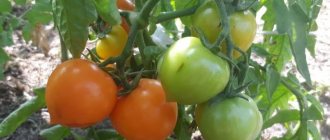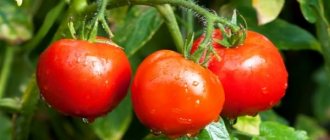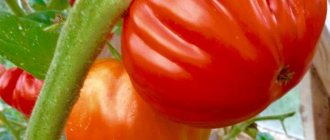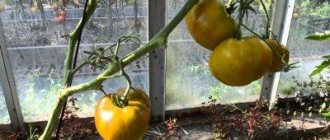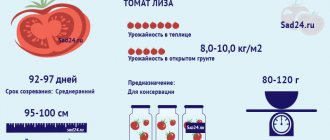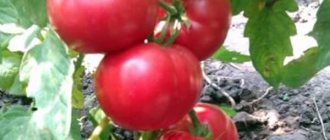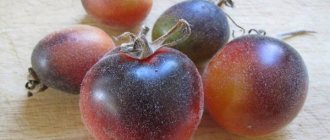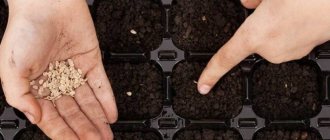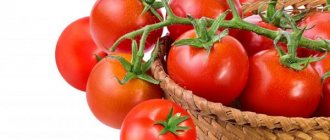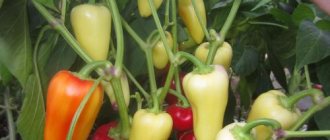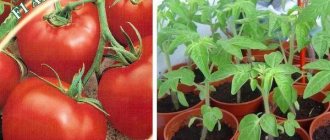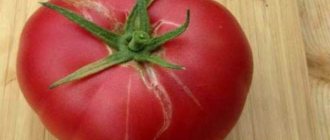The abundant tomato “Mashenka” will give an excellent harvest, even when grown by a novice gardener
The Mashenka tomato is another wonderful gift from breeders to Russian gardeners and farmers. In 2011, it was recognized as one of the best new varieties.
Mashenka’s fruits are distinguished not only by their excellent taste, but also by their exceptional health benefits. They contain many vitamins, pectins, minerals, proteins and organic acids.
Show content
Tomato “Mashenka”: description of the variety
| Variety name | Mashenka |
| general description | Mid-season indeterminate variety |
| Originator | Russia |
| Ripening period | 112-116 days |
| Form | Round, slightly flattened |
| Color | Red |
| Average weight of tomatoes | 210-260 grams |
| Application | Dining room |
| Productivity of the variety | 25-28 kg per sq.m |
| Features of cultivation | Standard agricultural technology |
| Disease resistance | Highly disease resistant |
It belongs to the tall indeterminate varieties; the length of the shoots can reach 2 meters or more. It is not a standard bush. The tomato is mid-season, the fruits ripen 112–116 days after emergence.
One of the main advantages of the variety is its high resistance to many diseases characteristic of tomatoes. Mashenka is practically not affected by tobacco mosaic, fusarium, alternaria and late blight.
The yield of the variety is very high! From one bush you can collect from 5.5 to 12 kg. The average yield per square meter of planting is 25–28 kg.
You can compare the yield of this variety with others in the table below:
Pros:
The main disadvantage is that it requires pinching and tying up.
Fruit characteristics
- Mashenka’s fruits are very large, even gigantic, round in shape, flattened at the top and bottom.
- Average weight - 210–260g, maximum - 630g.
- The coloring is even, monochromatic, deep red.
- There is no green spot near the peduncle; there are no inclusions.
- There can be 4 or 6 cameras.
- Dry matter is about 4.8–5.1%.
- Sugars 4–4.2%.
- The fruits do not last very long - only 2-3 weeks.
Mostly salad due to the large size of the fruits, which simply will not fit through the neck of the jar. Also used to make juice, sauce and paste.
The fruits are distinguished by very friendly, almost simultaneous ripening.
You can compare the weight of fruits with other varieties in the table below:
You can see photos of the “Mashenka” tomato variety below:
Features of cultivation
Tomato Mashenka is suitable for the Central and Central Black Earth, North Caucasus regions, as well as the Urals, Volga region, Western and Eastern Siberia.
To obtain seedlings, it is recommended to sow seeds in March, the deadline is early April. Before planting in a permanent place, the seedlings are fed 2 or 3 times with a special complex for seedlings.
It can be transplanted into open ground in the third ten days of May or the first ten days of June. Planting should be done according to the 65x45 cm pattern.
Important! It is better to form a bush into one shoot, cutting off all the stepsons. It must be tied to a vertical or horizontal support so that the stem does not break under the weight of the fruit
Watering and fertilizing are carried out according to the standard scheme. When 4–6 bunches of fruit form on the shoot, the top needs to be pinched to stop further growth.
Read useful articles about fertilizers for tomatoes:
- Organic, mineral, phosphorus, complex and ready-made fertilizers for seedlings and the TOP best.
- Yeast, iodine, ammonia, hydrogen peroxide, ash, boric acid.
- What is foliar feeding and when picking, how to carry it out.
Pests and diseases
Among the harmful insects, aphids can attack. To get rid of it, you can use insecticides such as Iskra M, Decis Profi, Confidor, Aktara, Fufanon, Actellik.
No less harm can be caused by cutworm caterpillars. They actively eat leaves and reproduce very quickly. Chemicals such as Confidor, Coragen, Fastak and Proteus will help eliminate the threat. You can catch adult butterflies using pheromone traps.
The Mashenka tomato variety is high-yielding and unpretentious. It does not suffer from temperature changes, diseases and various stresses, so it is suitable even for novice farmers and gardeners.
Video
We invite you to familiarize yourself with other productive tomato varieties in the following video:
In the table below you will find links to articles about tomatoes with different ripening periods:
Protection from diseases and pests
The Mashenka variety is resistant to major crop diseases. Agricultural techniques help reduce the risk of diseases: ventilating the greenhouse, rationing watering, weeding. If dark spots or other symptoms are detected, the plantings are treated with Ridomil or Topaz.
Pests cause significant damage to vegetable crops. The most dangerous for tomatoes are thrips, spider mites, aphids, and mole crickets. Folk remedies help fight insects: infusions of onion and garlic peels, wood ash. Extreme measures are the use of insecticides Iskra or Fufanon.
Tomato yield Mashenka
According to reviews, the Mashenka tomato from Biotechnika bears the largest fruits. Some specimens reach 600 g. From 6 to 12 kg of fruits are removed from the bush. Depending on the planting density, the yield per 1 sq. m reaches 25 kg of tomatoes. Fruiting is positively affected by good lighting, moisture and nutrients.
Description and yield of tomato Nasha Masha with photos and reviews
This variety, included in the State Register in Russia for plots and various farms to be grown under film cover, is rightfully considered a masterpiece of domestic selection. It is in greenhouse care that he most fully realizes his own potential.
Fruit and varietal characteristics of “Our Masha”
Tomatoes of this variety belong to an early ripening hybrid of the indeterminate type. The plant is medium-sized, with medium-sized leaves of a dark green hue. Tomatoes have a simple inflorescence, the first of which is located above the tenth leaf. All subsequent ones appear every three sheets.
Tomato trusses are simple; each of them bears an average of five fleshy fruits. The entry into fruiting begins after a hundred days or a little more than 3-4 days. About 8-10 kilograms are usually removed from one square meter.
As for the tomatoes themselves, the following features are noted:
- cube-shaped fruits;
- medium ribbing;
- smooth, thick skin;
- the color of unripe tomatoes is green with a darker shade near the stalk, and that of ripe tomatoes is red;
- the presence of 4 or more seed nests;
- by weight – 180 -200 grams;
- optimal taste characteristics - grainy-sugar plan on the break.
It turns out that the variety is very prolific and ready for rapid ripening. Ideal for salad use.
About the advantages of “our Masha” tomatoes
The undeniable advantages of the variety include:
- good yield;
- presentation of the fruit;
- large size of tomatoes and beautiful shape;
- excellent taste qualities;
- resistance to difficult weather conditions, including low light levels;
- resistance to fusarium, cladosporiosis and tobacco mosaic virus.
About the features of planting and caring for the described variety
“Our Masha” suggests sowing seedlings in the middle of the first spring month. Picking should be done when one or two true leaves appear. Seedlings are planted in mid-May under film cover, and in open ground at the beginning of the summer period. The age of the sprouts is two months or a little more for a couple of days, and when planting, adhere to the 60x50 cm pattern.
: Such tomatoes practically do not grow in soil conditions. Optimal organization of greenhouse conditions in the northern Russian regions and at high humidity levels.
In order for plants to develop properly and bear fruit abundantly, standard actions are necessary:
- timely watering, preferably in the afternoon;
- weeding on a regular basis;
- sufficient provision of light;
- loosening process;
- fertilizing with mineral fertilizers.
This is important: The optimal means for tomato growth are stimulants and regular watering. At the same time, special drugs should not be in excess: an overdose will not give the desired result, and will even do more harm. You may be interested in:
You may be interested in:
Taking into account the characteristics of the stems and leaves of tomatoes, it can be stated that the plants are susceptible to attacks from Colorado potato beetles. To eliminate these types of parasites, a soap-based solution is used. Otherwise the tomatoes may die
Otherwise, the tomatoes may die.
In order to successfully grow “Our Masha” F1, the seeds are planted by gardeners themselves, without seeking the help of experts. Reading literature can also be used, but the best mentor is personal experience. This is precisely what the reviews of those who planted “Our Masha” testify to.
“Our Masha” in the judgments of gardeners
According to reviews from gardeners, removing and eating the pulp of such tomatoes is relevant already after 60-65 days after planting. Most are very pleased with the harvest, even emphasizing that it is difficult to expect more worthy results. Meatiness and abundance are the main advantages of Nasha Masha, although its taste is not outstanding.
Igor, 38 years old
Marina, 57 years old.
On the advice of neighbors, I planted “Our Masha” in a greenhouse. The taste is not bad, juicy, but, most importantly, I liked the variety for the strong condition of the bushes and their resistance to cladosporiosis. The yield was also impressive; about 9 kilograms were collected per square meter. The fresh salads were delicious.
Some gardeners in the southern regions celebrate harvesting two or three times a year. At the same time, the vast majority are engaged in work in the greenhouse. Everyone mentions the use of stimulants and other beneficial products for the rapid growth and development of tomatoes.
So, “Our Masha” has its undeniable advantages over other tomatoes
It is possible to achieve the creation of preconditions for the desired development and growth, and it does not matter in what climate this will occur. After all, the main thing for any lover of a piece of land is love for the land and what you plant
How to grow tomatoes
When seedlings are planted in beds or in a greenhouse, the next stage of crop cultivation begins, associated with flowering and fruiting. During this period, more attention is paid to the above-ground parts of plants.
Landing rules
Bushes that have formed 3-4 pairs of true leaves and one flower cluster are planted in a permanent place. No more than 4 plants are placed on a plot of 1 m2, the depth of the holes is 30 cm.
Before picking, fertilizers are applied to each bush:
- a handful of humus;
- 1 tbsp. l. wood ash;
- 10 g superphosphate;
- 5 g potassium sulfate.
After planting, the ground around each bush is carefully mulched. It is better to use straw or sawdust, but other natural materials will also work.
Care during the growing season and fruiting
Tomatoes are watered at the root with settled warm water in the afternoon, when the soil is well warmed up. The soil around the bushes should remain loose, permeable to air and free of weeds.
During the flowering period, tomatoes are fed twice a month with complex mineral fertilizers: Floromix, Ecolist, Basfoliar. Every 10 days, the bushes are pruned: the side shoots are cut off, leaving petioles 1-2 cm long.
The bushes of the hybrid Nasha Masha are formed into 2 stems. They are tied to a support, and supports are installed under heavy fruit clusters.
Features of cultivation and possible difficulties
Thanks to its powerful root system, the Nasha Masha tomato is able to remain without moisture for a long period. When the fruits have already set, rare but abundant moisture is preferable.
The hybrid has heavily leafy shoots with numerous leaves and shoots. If the lateral shoots become more than 10 cm, the yield drops by 40–60%.
Diseases and pests
The culture is resistant to fusarium, cladosporiosis and tobacco mosaic virus. To prevent late blight, bushes are regularly sprayed with Ridomil Gold, Fitosporin, and Bordeaux mixture.
The most dangerous insect pests are:
To combat them, insecticides “Fitoverm”, “Confidor”, “Aktofit” and others are used.
Agricultural technology of tomato variety Mashenka
Tomatoes of the Mashenka variety are grown through seedlings. Seeds are planted at home. When the seedlings grow up, they are transferred to a permanent place. Care is important for tomatoes throughout the growing season.
Growing seedlings
Mashenka tomato seeds are planted in March. Boxes or plastic containers with holes are prepared for them. It is most convenient to use separate containers or peat tablets. This way you can avoid picking seedlings.
Tomatoes require light, fertile soil. The soil is taken from the site or a ready-made substrate is bought in the store. The soil is poured into containers and the seeds are placed on top. Leave 1.5 cm between them. When planting Mashenka tomatoes in peat cups, place 2 - 3 seeds in each cup. Subsequently, the healthiest seedling is selected. After planting the seeds, a layer of soil or peat no more than 1.5 cm is poured on top. The soil is watered and the containers are covered with polyethylene.
When the seeds germinate, the containers with tomatoes are moved to the windowsill. The seedlings are regularly cared for: watered with warm water, protected from drafts, and provided with lighting 12-14 hours a day.
Picking is carried out when the plants have a 2nd leaf
The tomatoes are carefully removed from the containers and placed in separate cups. When transplanting, choose the most powerful and healthy plants. After picking, water the soil
For the first 5 - 7 days, the temperature in the room is maintained at 16 - 18 ° C
After picking, water the soil. For the first 5 - 7 days, the temperature in the room is maintained at 16 - 18 ° C.
Landing rules
Tomatoes are ready for transplanting into a greenhouse or outside at the age of 55 - 60 days. The beds for the crop are prepared in the fall. The soil is dug up and fertilized with rotted manure. Tomatoes develop best after root vegetables, cabbage, cucumbers, onions, and herbs. Planting after tomatoes, potatoes, and peppers is not recommended.
Tomatoes require good lighting and fertile soil. In cool climates, seedlings are planted in a greenhouse or greenhouse. In the south, the bushes grow well in the open air.
A cloudy day is chosen for transplantation. Planting holes 30 cm deep are prepared in the garden bed. The plants are removed from the container along with the earthen lump and transferred to a new place. Then the soil is compacted and watered. Planting density – no more than 3 plants per 1 sq. m.
Watering and fertilizing
Mashenka tomatoes tolerate short-term drought. On average, bushes are watered every week. Plants need moisture during the flowering period to set fruit. For 1 sq. m pour up to 5 liters of warm, settled water. When the crop ripens, watering is reduced to 2 - 3 liters so as not to cause cracking of the tomatoes.
After planting in the ground, the tomatoes are fed with slurry. After flowering, fertilizing is applied based on superphosphate and potassium salt. For 10 liters of water, 35 - 40 g of each fertilizer is required.
Universal fertilizer for tomatoes – wood ash. It is applied to the soil or added to water before watering. Feeding is carried out no more than once every 2 - 3 weeks. It is allowed to use ready-made mineral complexes developed specifically for tomatoes.
Pinching and tying
According to its characteristics, the Mashenka tomato belongs to the tall variety. Therefore, plants require pinching. Excess shoots growing from the leaf axil are cut off by hand. The procedure is carried out until the stems reach a length of 5 cm.
For tying, separate supports made of metal or wood are used. You can stretch a rope between them every 30 cm. The tomatoes are tied to the resulting trellis near the stem.
Formation
Bushes of the Mashenka variety are formed into 2 stems. 4 - 5 brushes are left for each stem. With this scheme, the plants bear fruit well, and the tomatoes are illuminated by the sun. When fruiting begins, all the leaves in the lower part of the bush are torn off.
Advice from experienced gardeners
Due to the wide distribution of the variety, numerous reviews from gardeners about Mashenka tomatoes have been collected. They allow you to highlight strengths and weaknesses, as well as collect a number of tips from those who have already grown it.
- In greenhouse and open ground conditions, yields differ between varieties from the same manufacturer. The best results were obtained when grown indoors.
- The plant is formed into 1-2 stems. No more than 5 brushes are left on the bushes. This is necessary to prevent the stem from breaking.
- The bushes require pinching and staking. Plants need support throughout their growth and during fruit ripening.
Every housewife who has already planted Mashenka tomatoes and tasted them returns again to this variety. The main advantage is the ability to collect seeds from the harvest and re-sow them next year.
Tomato "Shuttle": description of the variety
| Variety name | Shuttle |
| general description | Early ripening variety of determinate type |
| Originator | Russia |
| Ripening period | 95-110 days |
| Form | Elongated, cylindrical |
| Color | Red |
| Average weight of tomatoes | 50-60 grams |
| Application | Universal |
| Productivity of the variety | up to 8 kg per square meter |
| Features of cultivation | No more than 4 bushes per square meter |
| Disease resistance | Prevention is necessary |
A variety of Russian selection, suitable for cultivation in all regions of Russia, except the northern ones. It is recommended to plant in open ground, in greenhouses and under film, in glass or polycarbonate greenhouses. In closed ground conditions, fruiting occurs 2 weeks earlier and lasts until frost.
Compact bushes can also be planted in pots and flowerpots and placed on loggias and window sills. The harvest is well stored and tolerates transportation well.
Shuttle is an early-ripening, high-yielding tomato variety. From sowing the seeds to the formation of fruits, 95-110 days pass. The bush is determinate, very compact, standard type. Read about indeterminate varieties here. The size of an adult plant does not exceed 50 cm. The amount of green mass is average, the bush does not require formation and pinching. 6-10 ovaries are formed on the branches, the fruits ripen gradually throughout the summer.
Among the main advantages of the variety:
- tomato "Shuttle" has good yield;
- tasty, fleshy fruits;
- compact bushes save space in a greenhouse or garden bed;
- very long fruiting period, tomatoes ripen from June until frost;
- low maintenance requirements;
- cold resistance;
- The fruits are suitable for fresh consumption and also for canning.
You can compare the yield of the Chelnok variety with other varieties in the table below:
| Variety name | Productivity |
| Shuttle | up to 8 kg per square meter |
| Russian size | 7-8 kg per square meter |
| King of Kings | 5 kg per bush |
| Long Keeper | 4-6 kg per bush |
| Grandma's gift | up to 6 kg per square meter |
| Podsinsky miracle | 5-6 kg per square meter |
| Brown sugar | 6-7 kg per square meter |
| American ribbed | 5.5 kg per bush |
| Rocket | 6.5 kg per square meter |
| De Barao the giant | 20-22 kg per bush |
Despite numerous advantages, the variety also has minor disadvantages:
- tomatoes require preventive measures against late blight and viral diseases, disease resistance is average;
- the bushes tolerate low temperatures well, but in cool summers the number of ovaries decreases.
Farmer reviews
Reviews from those who planted these tomatoes unanimously rate Mashenka as a reliable variety that is definitely worth growing on your own plot. Particularly noteworthy are the friendly maturation and high quantitative indicators. Here are the opinions of some gardeners:
Natalya, Zelenograd:
“I’ve been growing it for several years now. The main advantages of the crop: unpretentiousness, good fruiting, excellent presentation. I like that the seeds from the ripened vegetables can be reused.”
Elena, Krasnodar:
“I love working in the garden. For the second year in a row I am growing Mashenka. Care consists of timely watering, tying, pinching and fertilizing. I collect 25 kg of fruit per square meter. The tomatoes are first class. All winter with vegetables.”
Description of the hybrid tomato Tmag 666 f1 and cultivation in open ground
Tomato Tmag 666 f1 was bred by Chinese breeders. It is recommended to grow it on large farms with large acreage. The hybrid has excellent taste. On personal farmsteads, you can cultivate this tomato in greenhouses and open ground. Due to the small size of the bush, tomato can be grown at home. The fruits of this variety are used fresh.
Technical data of the plant and its fruit
The characteristics and description of the Tmag variety are as follows:
- The first harvest can be obtained 90 days after planting the seedlings.
- The height of a tomato bush ranges from 0.3 to 0.7 m. The leaves on the stems are large and colored green. They protect ripe fruits well from exposure to ultraviolet radiation.
- The Tmag tomato has a powerful stem and a well-developed root structure.
- The fruits of the described plant are spherical in shape. They are painted in bright red tones. Ripe berries do not have a green spot in the stalk area.
- The weight of the fetus ranges from 0.26 to 0.3 kg. If all agricultural standards are observed, farmers manage to obtain berries from the first harvest weighing 0.4 kg. The pulp of the berries is juicy and has sufficient density.
Reviews from gardeners growing the described tomato variety show that its yield is 6-7 kg of berries per 1 m² of bed. Some gardeners manage to get a harvest of 7.5-8 kg of berries per 1 m². Farmers note the plant’s ability to resist diseases such as verticillium, Alternaria cancer, and yellow wilt. Growing a plant is not very difficult even for a novice gardener.
Due to the high density of the pulp, the fruits can withstand long-term transportation. Berries can be stored in a cold room for up to 30 days. In Russia, it is recommended to grow the described type of tomato in open ground in the Krasnodar Territory and other southern regions.
If a farmer lives in central Russia, then to grow the plant you will need a film greenhouse without heating. In Siberia and the Far North, tomatoes of the described type are grown in well-heated greenhouse blocks.
How to grow tomatoes in your garden
After purchasing seeds, they can be immediately planted in boxes for germinating seedlings, since the manufacturer pre-sales the seed fund with fungicides.
It is recommended to sow seeds in mid-March. To do this, you need to first compact the soil, sprinkle it with peat or a layer of soil up to 10 mm high. The seeds are buried 15 mm into the soil and watered with warm water (a spray bottle is used). After this, the boxes with future seedlings are covered with film.
In order for the sprouts to germinate at the same time, it is recommended to place the container with seedlings in a place well lit by the sun. After the shoots appear, the film is removed. The temperature in the room with seedlings must be maintained at +18…+20°C.
The planting scheme for the described tomato is 2-3 plants per 1 m² of bed. To prevent the branches of the bushes from breaking off when the fruits ripen, they are tied to strong supports. The plant forms the bush on its own, so there is no need to pluck its top.
It is recommended to pick off the lower leaves on the bushes once every 6-7 days. This operation should be carried out only on sunny days. Be sure to carry out weeding, hilling and watering the plants with warm water. To maintain moisture in the soil, after each watering it is necessary to loosen the soil under the bushes. If a tomato is grown in a greenhouse, then the room is regularly ventilated to create the necessary air circulation.
Feeding the bushes is carried out 3 times during the entire growing season. For this purpose, organic and mineral fertilizers containing nitrogen, potassium and phosphorus are used. To protect plants from diseases, they are treated with fungicides and infected leaves are removed from the bushes. When garden pests attack tomatoes, it is recommended to destroy them using chemicals or folk remedies.
https://youtube.com/watch?v=kiMy73eKP60
How to tie up bushes
In a greenhouse, tying up tall bushes is easy - usually ropes are stretched from above, along which the plants then climb. But in open ground, it is often necessary to construct special devices for gartering.
Bushes can also be tied to pegs, but in this case you will need very long sticks - about 2 m in height each. The main thing is that you will need a lot of such sticks - a peg for each bush. You need to tie it with soft ropes or tear an old sheet into narrow strips. It is better to boil the fabric first so that it is sterile.
Using a trellis, tying up tall tomatoes is easier and more effective. The stakes, approximately 2 m high, need to be driven in at a distance of 4 m from each other. A wire is stretched between them, connecting the upper points. And long fabric ropes are already tied to it, along which the tomatoes will subsequently curl. Do not pull the rope too tightly, as during cultivation you will squeeze the stem and damage the bush.
See also
Description of the hybrid tomato variety Makhitos F1 and growing seedlings
Read
There is another option for tying to a trellis. The stakes, as in the previous example, are installed at a distance of 4 m from each other. Several rows of wire are stretched between them at intervals of about 70 cm. Fabric ropes are stretched across at more frequent intervals (about 30 cm). In this way, a grid is constructed along which the bushes will subsequently curl.
Description of the variety
Tomatoes Mashenka are one of the largest young and, at the same time, most distant hybrids of the Russian breeding school. Plants of this variety are distinguished by their inflexibility and increased productivity, which makes it possible to eliminate high yields in the minds of a peaceful climate. In addition, these plants are considered to be one of the most universal and suitable for any cultivation, so they can be successfully cultivated both in greenhouses and in open ground.
Do you know? Despite the fact that tomatoes are considered one of the most ancient cultivated plants, the fruits were consumed in the territory of Europe by heifers in the 16th century.
Main characteristics of the tomato variety Mashenka:
- the range of meanings both for amateur and commercial cultivation;
- the variety is middle-aged, from the moment the first fruits appear, they appear in 95-100 days;
- bushes of indeterminate type, tall, up to 2 m in height;
- As the trees mature, they grow thicker and grow with large leaves and thick stems;
- the variety is not standard;
- The yield per bush is 5-12 kg;
- tomatoes are formed into a regular round shape;
- the skin of the tomatoes is smooth, in a deep red color, with a characteristic glossy appearance;
- The weight of one fruit is approximately 250 m, but in optimal conditions the fruit can grow up to 500-600 g;
- the taste of the fruit is soft, with a rich tomato aroma and a sweet and sour taste;
- fruits of the Mashenka variety can easily be transported;
- fruit set is possible regardless of the weather;
- The plants are practically not affected by mosaic, late blight, fusarium, as well as other infections associated with paslon.
Planting seedlings in a permanent place
Tomatoes are transferred to open soil when stable warm weather develops, with a night temperature of at least +10–15 °C. By this time, the plants should lengthen to 30 cm, and at least 6–7 true leaves should form on their shoots. Depending on the climate of the growing region, this period usually falls between early May and late June. In this case, the age of young tomatoes should be 55–65 days from the moment of germination.
Plants are planted in previously prepared and fertilized soil. Most often, row and hole planting methods are used for this. When planting in rows, even parallel rows are formed on the site, with a row spacing of 35–40 cm. With the hole method, small holes are dug in the soil at a distance of 30–40 cm from each other. Regardless of the planting method, the depth of the hole for tomatoes should be about 20 cm.
Advantages and disadvantages
- Main advantages of culture:
- increased productivity (about 28 kg per 1 sq. m);
- high fruit vigor;
- great mass of tomatoes;
- The ripening of tomatoes takes a short hour, so in 1-2 passes you can pick almost all the fruits;
- plants can be grown in any climatic minds, both for commercial and private cultivation;
- ripe tomatoes are ideal for a fresh look and for all culinary preparations;
- the level of resistance to the majority of infectious diseases and illnesses.
- Heads of the Mashenka variety:
- the supernatural growth of the tabernacles;
- The trees can grow as long as they can, otherwise their productivity decreases significantly;
- the maximum yield of the bushes is achieved only in the greenhouse;
- Mature fruits are stored for no more than 2-3 years;
- The fruits are practically not suitable for canning in whole form.
Harvesting and application
Fruit ripening is uniform, almost simultaneous. Ripening occurs in whole clusters, which simplifies their collection.
The use of ripe vegetables is universal: they are ideally combined in summer salads with other vegetables, they are a good basis for first courses, hot dishes and sauces. Tomatoes taste great when baked with meat.
Tomato products are prepared from them, such as lecho, ketchup, juices, pastes, adjika. Excellent taste retention in barrel pickles and marinades. But due to their large size, they are not suitable for whole-fruit canning.
Despite their thick skin, ripe vegetables cannot be stored for long; they are usually stored for no more than 2-3 weeks. Otherwise, the tomatoes will lose their presentation and taste.
How to grow seedlings
The hybrid is grown through seedlings in the standard way: sowing seeds in the ground and then planting them into individual containers. The procedure is carried out from late March to early April.
Preparing the soil and sowing seeds
Hybrid seeds are processed in production before packaging in bags, so at home they are not manipulated to disinfect and increase germination.
Experienced farmers advise calibrating seeds. This will help identify empty and too small grains. To do this, the seed is soaked in salt water for 5-10 minutes (1 tsp per 200 ml). Anything that floats to the surface is not suitable for sowing. The seeds remaining at the bottom are carefully washed with warm water.
You can get soil for seedlings at a gardening store. Such a substrate is already enriched with nutrients. Most gardeners prefer to prepare the soil themselves from a mixture of black soil, river sand and peat in a 1:1:1 ratio. Superphosphate is suitable as a fertilizer - 40 g per bucket of soil.
Advice. Before use, the soil is heated in the oven at a temperature of 110 ° C or steamed in a double boiler. A strong solution of potassium permanganate will disinfect the soil and prevent the development of bacteria.
For growing seedlings, boxes, trays, containers, tetrapacks, and pots 5-7 cm deep are suitable. They are filled with moist soil and the grains are sown in furrows 1.5-2 cm deep with an interval of 2 cm.
The containers are covered with plastic wrap and placed in a dark place. The optimal temperature for seed germination is 23 °C. In such conditions, seedlings will appear after 4-5 days.
Seedling care
After the seeds hatch, the film is removed and the boxes are placed on the windowsill on the south side. To prevent seedlings from stretching upward, the duration of daylight should be at least 16 hours. If there is little sunlight, the seedlings are placed under fluorescent lamps.
Water as needed: 1-2 times a week. An infusion of eggshells is suitable as an additional feeding. It’s easy to prepare: shells of 10 eggs are poured into 3 liters of water and left for 6-7 days. A cloudy liquid and a characteristic odor indicate the readiness of the fertilizer. The infusion is used to water seedlings once a week.
A week before planting in the ground, the seedlings are taken out into the fresh air to harden for half an hour.
The lower leaves are torn off as they grow, and the seedlings are hilled up to strengthen the rhizome.
Features of cultivation
Mashenka tomato seedlings can be grown without picking or the plants can be transplanted after the appearance of 2 leaves. It is advisable to prepare the bed in the fall by digging up the soil and filling in rotted manure. Soil for seedlings can be purchased at the store or made independently using garden soil and peat (in equal quantities) with a pinch of sand and wood ash.
You can also prepare a mixture of turf soil with compost and humus in a ratio of 2:1:1. First, the soil is shed with a weak solution of potassium permanganate or calcined in the oven for 15 minutes at a temperature of 130 degrees.
Mashenka tomato seeds are buried 1.5 cm, planting 2-3 grains in each container. Place in a warm place (25-26 degrees), water, cover with film with holes and add additional light for 13-14 hours. After 2 weeks, the temperature is lowered to room temperature and the film is opened. 15 days before transplanting into the ground, they are hardened at a temperature of 16-18 degrees.
Mashenka tomatoes can be grown without diving by immediately planting the seeds in peat pots
Mashenka tomatoes are transplanted in mid-May (into the greenhouse at the beginning of the month), placing them at a distance of 50 cm from each other (60-70 cm can be left between the rows). Watering 1-2 times a week, fertilizing with complex mineral fertilizer every 2-3. Be sure to mulch the soil, periodically loosen and weed. As soon as the bush grows to 1 m, it is tied to a support. When side shoots appear, they are pruned.
Characteristics of the variety
The tomato variety Mashenka belongs to the mid-early crops. The first fruits set 100 days after emergence. Disperses seeds. Fruiting is long. Harvesting takes place until the end of October, until frosts reach minus 5 °C.
Plants are planted in open ground and in a greenhouse. It all depends on the region in which the crop is grown.
Description of the bush and fruits
Based on the description, the bushes are of indeterminate type. They do not stop growing throughout the entire growing season. When planted in open ground, their height reaches 1.5 m. In a greenhouse they grow up to 1.7 m. There is little foliage. The leaf blade is medium in size, oval in shape and dark green in color.
The following characteristics of the fruit are noted:
- round shape;
- deep red skin color;
- the surface is smooth, non-ribbed;
- a small amount of seeds is contained in 4 chambers;
- average weight – 350 g.
According to the description, the yield indicators of the Mashenka variety are high. 10 fruits are formed on each brush. In open ground, up to 10 kg of crop is harvested from a bush.
In a greenhouse you can harvest 12-14 kg of tomatoes. Such characteristics are possible if all rules for caring for the crop are followed.
Usage
According to the description of Mashenka tomatoes, they contain a small amount of dry matter. This means that they are used primarily to create juices, sauces and tomato paste.
Fruits are good for making juice
Some housewives grow it for preparing fresh salads and canning. Due to their resistance to cracking, fruits retain their commercial quality well during heat treatment.
Resistance to adverse conditions
Based on their characteristics, tomatoes tolerate long-term frosts well. They can withstand temperatures down to minus 5 °C, thanks to which the crop bears fruit until the end of October.
This variety does not tolerate drought well, so watering should be frequent and plentiful. In addition to this, mulching is carried out, which protects the bushes and root system from drying out.
Resistance to diseases and pests
The immunity of the Mashenka tomato variety is good, so the crop is not affected by typical diseases (powdery mildew, root rot, tobacco mosaic and late blight). Signs of aphids and cutworms sometimes appear on the surface of plants.
Against aphids, use a solution of “Aktara” (20 g per 5 l of water) or “Decis” (50 g per 5 l). To combat the cutworm, use a solution of “Koragen” (60 g per 10 l) or “Fastaka” (1 ampoule per 3 l).
Tomatoes: advantages and disadvantages
The positive qualities of the tomato variety “Mashenka” include:
- High yield;
- Friendly and rapid ripening of fruits;
- High degree of fruit set;
- Excellent taste characteristics;
- Large fruit;
- Resistance to adverse weather conditions;
- Immunity to major tomato diseases and insect pests.
The disadvantages of this variety include:
- The need for gartering and pinching, since the variety is tall;
- Short shelf life of the harvested crop. Even the presence of a thick skin does not allow storing fruits for more than 2-3 weeks;
- To get a good, abundant harvest, grow tomatoes only in greenhouse conditions.
